| |
| Eastern Washington's Wenatchee Valley is called the Apple Capital, and for good reason. It’s impossible to spend time in and around the region without going apple-solutely bonkers. |
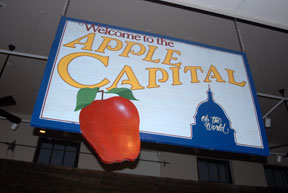
|
|
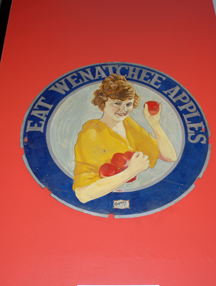
|
|
| |
Wenatchee is the Apple Capital |
|
Eat Wenatchee apples |
|
| |
|
|
| |
The Wenatchee Valley is all about apples, from many varieties to an incredibly edible abundance of apple spin-offs. The varieties include red and yellow delicious, Fugi, Breaburn, Cameo, Gala, Gingergold, Granny Smith, Jonagold, Pink Lady, Rome and winter bananas. While they're delicious off the tree, they're also made into a smorgasbord of tasty, nutritious delights—applesauce, baked apples, apple butter, aplets, apple slices, apple pizza, wrap apple sandwiches, apple jellies and, along with ciders, apple and cranapple juices. Then, add on treats and desserts like apple pie, apple tarts, apple pudding, candied apples, apple crisps, apple cakes, apple gallets and, the applesolute tastiest of all—apple butter milkshakes.
Apple appellations are part of Wenatchee Valley’s flavor. Since 1925, the “O” in The Wenatchee World’s newspaper masthead has been an apple. Apple Way is a downtown street. Wenatchee School District second graders study apples. The semi-pro baseball team is the Apple Sox. Washington's Apple Blossom Festival has been held in Wenatchee each spring since 1920. Wenatchee’s apple-shaped welcome signs proclaim it the “Apple Capital of the World.” |
|
| |
|
|
|
|
| |
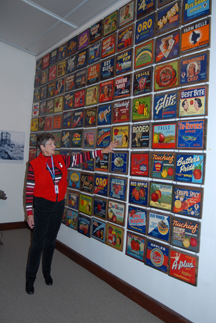 |
|
 |
|
| |
Wall of apple labels |
|
Antique apple machine |
|
| |
|
|
| |
The Wenatchee Valley Museum features an apple room with more than 200 apple crate labels and photos of apple festival queens. It also features the story of the Guinness Book of Records world’s largest apple pie, one built in 1997 in Wenatchee that measured 44- by 34-feet and weighed 34,438 pounds.
Washington ranks first in national apple production and grows 60 percent of the apples eaten in the nation. A majority come from the Wenatchee Valley, which has more than 170,000 acres of apple orchards and is the state's largest producer and exporter of apples. Apples are exported to 60 countries, with the highest volumes to Mexico, Canada, Taiwan, India and Indonesia. |
|
| |
|
|
|
|
| |
|
|
Philip Miller planted the Wenatchee Valley's first apple trees in 1872. The first commercial planting was the Peterson orchard in 1884. Commercial apple production blossomed because of the climate and availability of irrigation water, along with advances in processing, packing and railroads that shipped Wenatchee apples across the country. The first carload of apples was sent from Wenatchee to Seattle in 1901. By 1910, 2,400 carloads were shipped out.
During a visit, my mission included sampling the valley’s multiple varieties and visiting places where apple products are produced. |
|
| |
Apple harvesters in the mid-1900s |
|
|
|
| |
Workers at Aplets & Cotlets tour craft apple creations |
|
| |
|
|
| |
My sampling started north of Wenatchee in Cashmere at the free, family-friendly Aplets & Cotlets factory tour. Guided Country Kitchen tours meander around the plant, offering sights and smells of apples, which are blended with fruits and nuts into delectable varieties of natural, wholesome confections. There's always a liberal selection of free samples. The third generation business produced two million pounds of 40-plus apple products in 2009. The business was begun in 1920 by two Armenians from Turkey, who used the name Liberty Orchards to honor their new homeland. |
|
| |
|
|
| |
 |
|
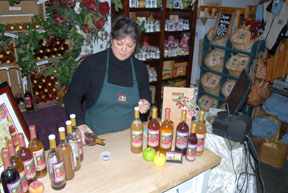
|
|
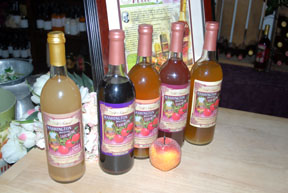
|
|
| |
Finished Aplets & Cotlets |
|
Marcia Green pours Lady Blush |
|
Wine alternatives |
|
| |
|
|
|
|
|
|
| |
After the Aplets & Cotlets feast, I sampled all-natural non-alcoholic ciders at the nearby Cashmere Cider Mill & Tasting Room. Owners Marcia and Lyle Green pour up to 10 varieties, including their full-bodied Lady Blush. "Our goal is to be a wine alternative," Marcia explained, pouring samples into wine glasses and encouraging tasters to savor the fruit-flushed aroma. "It fills all the requirements, except it's extra healthy." The ciders were tasty, but Marcia had a surprise: lead-us-into temptation oh-so sinfully delicious apple butter milkshakes. |
|
| |
|
|
|
|
|
|
| |
 |
|

|
|
 |
|
| |
Shake it up baby |
|
Apple-solutely delicious |
|
The apple pie is great, too |
|
| |
|
|
| |
In Wenatchee, my sampling began with a visit to the Washington Apple Commission Visitor Center. Videos and interactive displays provide information about the apple industry and, of course, tastings of free apple juice and apple slices.
"A lot of people live in Seattle and don't even know we grow apples," said Todd Fryhover, the apple commission's president. To promote apples, the commission has used various slogans, including "No Other One Comes Close," "The Best Apples on Earth" and "The Original Health Food." After sampling several varieties, I'll nominate, "Coming Through in the Crunch."
A visit to the downtown Wenatchee Valley Museum helps apple history come alive. "It was part of the way the valley was settled," Billie Holt, a museum curator, explained of displays showing everyone from Phillip Miller to Mexican and Japanese field workers. |
|
| |
|
|
| |
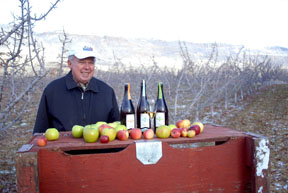 |
|
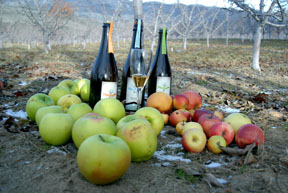 |
|
| |
Pete Ringsrud and his hard ciders |
|
Hard ciders and their apples |
|
| |
|
|
|
|
| |
But the most intoxicating aspect of my visit was a trip to East Wenatchee's Snowdrift Cider Company, makers of hard, or alcoholic, cider. Owner Peter Ringsrud makes cider with a 100-year-old hand crank press. He and his family began crafting artisan cider in 2003, focusing on styles made in Europe and the early American colonies, when cider was safer than water.
"We're going at it from more a wine-making process. We're definitely in the artisan spectrum," Peter explained, noting his family hopes to eventually bottle 1,500 to 2,000 cases a year. He's grafted heirloom apples with enchanting names like Dabinet, Calville Blanc d'Hiver, Foxwhelp and Wickson Craf, on their 60-acre orchard. Inside, he's worked wizardly magic blending five or six varieties into fruitfully aromatically ciders, including semi-sweet Cliffbreaks Bland, semi-dry Orchard Select, and English-traditional Dry Cider.
But Wenatchee is more than apples. In between apple samples I skied at the Mission Ridge Ski & Board Resort, which hosted slalom skiers from the U.S. Ski Team before the 2010 Winter Olympics in British Columbia.
It’s not necessary to be an Olympic caliber skier to savor Mission Ridge. The 2,000-acre mountain, just 12 miles from downtown Wentachee, is sometimes passed by because other ski areas are closer to snow-seeking crowds from Seattle, Tacoma and Spokane. As I learned, those who’ve never visited Mission Ridge don’t know what they’re missing. Mission Ridge’s snowmaking program is the Pacific Northwest’s most advanced and largest. The ski area hosts several races and, as resort spokeswoman Jerri Barkley boasted, “We’re turning into quite the racing boutique area.” |
|
| |
|
|
|
|
| |
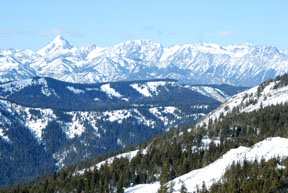 |
|
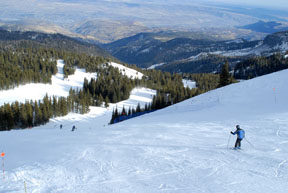 |
|
|
The view from atop Mission Ridge |
|
Zipping along |
|
| |
|
|
| |
While racers seek out the steep terrain, beginning to advanced skiers and snowboarders find a wide variety of ability-testing offerings while more advanced skiers have a broad choice of advanced intermediate and expert runs. There's night skiing. By night or day, the views are eye-popping. An express quad zips to the summit elevation at 6,820 feet, where the sightings include Mount Adams, Mount Rainier, Mount Stuart, Glacier Peak and row upon rows of jagged Cascades peaks. |
|
| |
|
|
| |
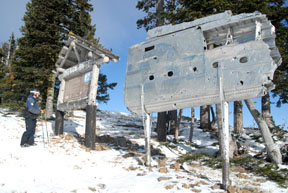 |
|
| |
The wing of a bomber |
|
| |
|
|
| |
A worthy detour at the junction of the Boundary Rad and Katsuk runs leads to the remnants of a B-24 bomber that crashed into Mission Ridge’s cliffs on a rainy, foggy night September 30, 1944. The entire six-member crew, on a training flight, was killed by the impact. Most of the plane was destroyed but a wing was removed in 1985 and first moved to the base area. It was returned to the crash site in 1993. Fittingly, the nearby cliffs are the Bomber Cliffs while a series of runs weave through the Bomber Chutes. From the top of Bomber Bowl, an intermediate run, are stunning views of glacially carved Eastern Washington, including the Columbia River, downtown Wenatchee and the Wenatchee Valley.
From the top, you can almost smell the apples.
When You Go
The Mission Ridge Ski & Board Resort is 12 miles from Wenatchee, Washington, at a base elevation of 4,570 feet. The vertical rise of 2,250 feet tops off at 6,820 feet, with dazzling Cascade views. The area is open from 9 a.m. to 4 p.m. Thursdays through Mondays, daily during holidays, with night skiing from 4 to 9 p.m. For updated information on the costs, snow conditions and other information visit their Website at www.missionridge.com or call 509-663-6543. Mission Ridge is 138 miles from Seattle, 165 from Spokane, 136 from the tri-cities, 303 from Portland, 249 from Sandpoint, Idaho and 22 from Leavenworth.
Nearby Wenatchee area attractions include a variety of Columbia River wineries, the Aplets & Cotlets Candy Kitchen, Performing Arts Center of Wenatchee, Town Toyota Center (home of the Wenatchee Wild Hockey Team and Wenatchee Valley Venom Football Team), and Wenatchee Valley Museum & Cultural Center. Cross country skiing and snowmobiling are also plentiful in the region. For information contact the Wenatchee Valley Visitors Bureau toll-free at 800-572-7753 or www.wenatcheevalley.org.
About the Author
Lee Juillerat is a writer-photographer for a Southern Oregon newspaper and frequent contributor to various magazines and other publications. He can be contacted at lee337@cvc.net. |
|
| |
|
|
|

